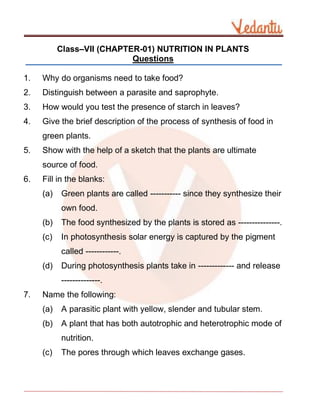
Ncert Solutions for Class 7 Science
- 1. Class–VII (CHAPTER-01) NUTRITION IN PLANTS Questions 1. Why do organisms need to take food? 2. Distinguish between a parasite and saprophyte. 3. How would you test the presence of starch in leaves? 4. Give the brief description of the process of synthesis of food in green plants. 5. Show with the help of a sketch that the plants are ultimate source of food. 6. Fill in the blanks: (a) Green plants are called ----------- since they synthesize their own food. (b) The food synthesized by the plants is stored as ---------------. (c) In photosynthesis solar energy is captured by the pigment called ------------. (d) During photosynthesis plants take in ------------- and release --------------. 7. Name the following: (a) A parasitic plant with yellow, slender and tubular stem. (b) A plant that has both autotrophic and heterotrophic mode of nutrition. (c) The pores through which leaves exchange gases.
- 2. 8. Tick the correct answer: (a) Amarbel is an example of : (i) Autotroph (ii) Parasite (iii) Saprophyte (iv) Host (b) The plant which traps and feeds on insects is: (i) Cuscuta (ii) China rose (iii) Pitcher plant (iv) Rose 9. Match the item in given column I with those in column II. Column I Column II Chlorophyll Bacteria Nitrogen Heterotrophs Amarbel Pitcher plant Animals Leaf Insects Parasite 10. Mark “T” if the statement is true and “F” if it is false: (i) Carbon dioxide is released during photosynthesis. (T/F) (ii) Plant which synthesis their food themselves are called saprotrophs. (T/F) (iii) The product of photosynthesis is not a protein. (T/F)
- 3. (iv) Solar energy is converted into chemical energy during photosynthesis. (T/F) 11. Choose the correct option from the following: Which part of plant gets carbon dioxide from the air for photosynthesis? (a) Root hair (b) Stomata (c) Leaf veins (d) Sepals 12. Choose the correct option from the following: Plants take carbon dioxide from the atmosphere mainly through their: (a) Roots (b) Stem (c) Flowers (d) Leaves
- 4. Class–VII (CHAPTER-01) NUTRITION IN PLANTS Answers 1. Organism needs food to (i) Survive (ii) Growth (iii) Gain Energy (iv) Damage repair (v) Maintain bodily functions (vi) Other activities. 2. 3. When starch comes in contact with iodine solution, gives a characteristic dark blue color. So, when we add a few drops of iodine solution on leaf and if the dark blue color appears, that will confirm the presence of starch in leaves. 4. In green plants, the synthesis of food occurs by a process called photosynthesis. During this process, chlorophyll in the cells of the leaves uses carbon dioxide and water to synthesize
- 5. carbohydrates in the presence of sunlight. The process can be represented by an equation: During this process oxygen is liberated and the formed carbohydrates is stored in the form of starch. 5. 6. Fill in the blanks: a. Green plants are called autotrophs since they synthesize their own food. b. The food synthesized by the plants is stored as starch. c. In photosynthesis solar energy is captured by the pigment called chlorophyll. d. During photosynthesis plants take in carbon dioxide and release oxygen. 7. (i) Cuscuta (ii) Pitcher plant (iii) Stomata 8. (a) (ii) parasite (b) (iii) Pitcher plant To get the full access of other chapters click here Ncert Solutions for Class 7 Science https://www.vedantu.com/ncert-solutions/ncert-solutions-class-7-science
- 6. 9. 10. (i) F (ii) F (iii) T (iv) T 11. (ii) Stomata 12. (iv) leaves To get the full access of other chapters click here Ncert Solutions for Class 7 Science https://www.vedantu.com/ncert-solutions/ncert-solutions-class-7-science
